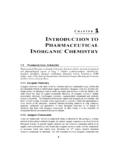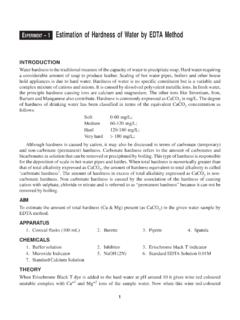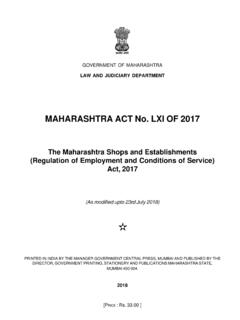Transcription of REGULATORY REQUIREMENTS FOR PHARMACEUTICAL PLANTS
1 CHAPTER 1 REGULATORY REQUIREMENTS FOR PHARMACEUTICAL PLANTS Introduction When we design a PHARMACEUTICAL plant we need to understand and follow the basic REGULATORY REQUIREMENTS for the construction of a PHARMACEUTICAL plant. These REQUIREMENTS are mainly divided into two categories namely - REQUIREMENTS related to good manufacturing practices currently followed in PHARMACEUTICAL industry. These are elaborately describe in the various international cGMP guidelines. REQUIREMENTS related to factories Acts and Rules, which is a Central Act and the rules described separately by each state in India, for this work we have referred the rules specified by the state of maharashtra . In addition to these, there are specific rules and regulations related to following activities which should be referred separately by the reader , Regulation related to water and air pollution. Regulation related to handling and storage of inflammable materials etc.
2 1 2 | PHARMACEUTICAL Facilities: Design, Layouts and Validation REGULATORY REQUIREMENTS Related to Current Good Manufacturing Practices in PHARMACEUTICAL Industry The cGMP REQUIREMENTS are described in the various guidelines which deal mainly in the following categories, , (a) REQUIREMENTS related to surroundings. (b) General REQUIREMENTS for PHARMACEUTICAL PLANTS . (c) REQUIREMENTS related to various departmental areas in the plant and (d) REQUIREMENTS related to special products. , sterile products. We will briefly deal with these guidelines below: (a) REQUIREMENTS Related to Surroundings of the Plant Part I of schedule-M of Drugs and Cosmetics Act- 1940 states the REQUIREMENTS in the following words- The factory building(s) for manufacture of drugs shall be so situated and shall have such measures as to avoid risk of contamination from external environment including open sewage, drain, public lavatory or any factory which produces disagreeable or obnoxious odour, fumes, excessive soot, dust, smoke, chemicals or biological emissions.
3 Only Indian cGMP guidelines specifically talk about surroundings of PHARMACEUTICAL plant. All other international guidelines talk in terms of General REQUIREMENTS and different plant areas. In the next section, we will review the General REQUIREMENTS related to PHARMACEUTICAL PLANTS . Comment Many countries have industrial zone concepts, , a particular type of industry planned by design in a particular part of the country, province or even city. When deciding this, the basic REQUIREMENTS of the industry are taken into account and hence selection of location for the organization is simplified. Presently in India also such industrial zones are coming up , Information Technology industry is coming up in Hyderabad, Bangalore, and Pune etc. Similarly PHARMACEUTICAL industry is coming up in places like Baddi in Himachal Pradesh, more similar PHARMACEUTICAL zones are expected come in more places in India.
4 Some of the major points to be considered in these cases are - Land cost, water sources, supply of electric power, extremes of climate like heavy rain, extremes of temperature, earthquake proneness, transport facilities for material REGULATORY REQUIREMENTS for PHARMACEUTICAL PLANTS | 3 and men, Availability of trained or skilled man power, Labour and industrial legislations, cost of living, etc. (b) General REQUIREMENTS for PHARMACEUTICAL PLANTS After reviewing the leading international cGMP guidelines, we can summarize the same in the following points. 1. PHARMACEUTICAL PLANTS must be located, designed, constructed, adapted and maintained to suit the operations to be carried out. 2. Their layouts and design must aim to minimize the risk of errors and permit effective cleaning and maintenance, in order to avoid cross-contamination, built up of dust or dirt and in general any adverse effect on the quality of the product and safety of the personnel.
5 3. The Canadian guidelines are similar to above 1 and 2 but adds one point or Orderliness in the plant and specifically talks about preventing contamination of drug and addition of extraneous materials to the drug. It also talks about regular maintenance of the PLANTS to prevent deterioration of the premises and finally says that the Ultimate objective of all endeavours is product quality. Comment PHARMACEUTICAL PLANTS must be designed so that they must meet following REQUIREMENTS . They should be easy to clean, maintain and operate. These factors must be taken into account while designing the plant layout and detailed exercises should be carried out for men and materials movement, considering the manufacturing flow charts of the products to be manufactured. Zigzag movements of men and materials should be avoided as far as possible. Avoiding cross contamination and mix-ups is the main idea in designing the pharma PLANTS and working out their layouts.
6 Layouts include equipment, subsection, section, department etc. Equipment or workstation is the basic unit of operation , a compression m/c for tablets, a sifter, a capsule filling m/c etc. For avoiding cross contamination and mix-ups the flow of materials is to be considered as primary aspect and other aspects like, storage of intermediate materials at different stages of processing and packing and also the separation of air handling unit must be considered to avoid contamination of materials. Manufacturing PLANTS must be situated in such an environment which protect all the manufacturing processes by minimizing the risk of contamination of / Intermediate and finished products. 4 | PHARMACEUTICAL Facilities: Design, Layouts and Validation Comment Protecting manufacturing processes in plant from contamination involves control on the environment. A careful planning of HVAC system must be done to avoid contamination.
7 Following points must be considered while doing this , segregation and clearly defining the scope of individual air handling unit so that only one product is being exposed in that area at any time of operation. Duct and filter cleaning procedures must be well defined and documented. The HVAC system details must be worked out very critically, these include details like, Temperature Humidity Differential pressure Air changes per hour Class of air etc. Even SOPs related to movement of men from one workstation to other workstation must be clearly defined. The seven zone concept of area planning may be worth considering while planning the layouts of PHARMACEUTICAL operations. The Dholka plant of Cadila Pharmaceuticals Ltd., was pioneer in this area. 5. Manufacturing PLANTS should be so constructed that they can always be kept in clean and sanitized conditions.
8 Comment The vacuum cleaning lines laid down in PLANTS with connections at suitable points may be a fast and easy method of cleaning. These can at least be planned for major corridors and if well planned with a powerful central vacuum system other workstations may also be connected to this. The dry dust may be collected by this way at few selected points in the PLANTS , eliminating physical transfer of collected dust from the plant. Suitable trash collection systems may also be planned. Trash collection points may be planned in each section or subsection. Each such trash collection point may have recycled plastic bags put in a suitable wire meshed containers and these bags may be collected along with collected trash at least twice in a shift of 8 hours or whenever required. Sanitization SOP and records must be in place and followed. Sanitization SOPs should be clearly described for different areas , corridors, engineering service areas, wash places, change rooms, linen rooms, non-sterile processing areas, primary and secondary packaging areas REGULATORY REQUIREMENTS for PHARMACEUTICAL PLANTS | 5 and sterile processing areas.
9 Aseptic operations areas must have vacuum cleaners made up of at least and fitted with additional HEPA filters. The people doing sanitation work in aseptic areas must be specifically trained in entry and exit from the aseptic area, and method of handling sanitation equipment and other materials like detergents and disinfectants etc for this purpose substances like cresol with soap, (Lysol) which are highly caustic and can result into physical accidents because of its contact to skin or eye etc people must be trained in safety procedures for using such materials and methods of dealing with accidental injuries by such caustic substances. consider the role of sanitary supervisor as one of the important positions and its detailed job description is demanded by inspectors during their plant audits, hence well experienced and suitably qualified people should be put in charge of this position.
10 Records of sanitary work carried out as per laid down SOPs must be maintained. 6. Manufacturing PLANTS should always be kept in a good state of repair. It should be so designed, so that the maintenance operations can be carried out without affecting the product quality. Separate service lanes may be provided. 7. SOPs and records should be kept for cleaning, maintenance, disinfection and sanitization. 8. PLANTS should be maintained in order with reference to Electric supply Lighting Temperature Humidity HVAC You should have specifications and records of maintenance about the above mentioned points. Comment A detailed SOP and relevant records should be maintained for building maintenance. The maintenance activities should cover following areas at the minimum. (i) Wall and ceiling surfaces. No peel off of paint is permissible; and such situation must be immediately repaired, this is to be considered as one of the main source of material contamination in the processing or other areas.











